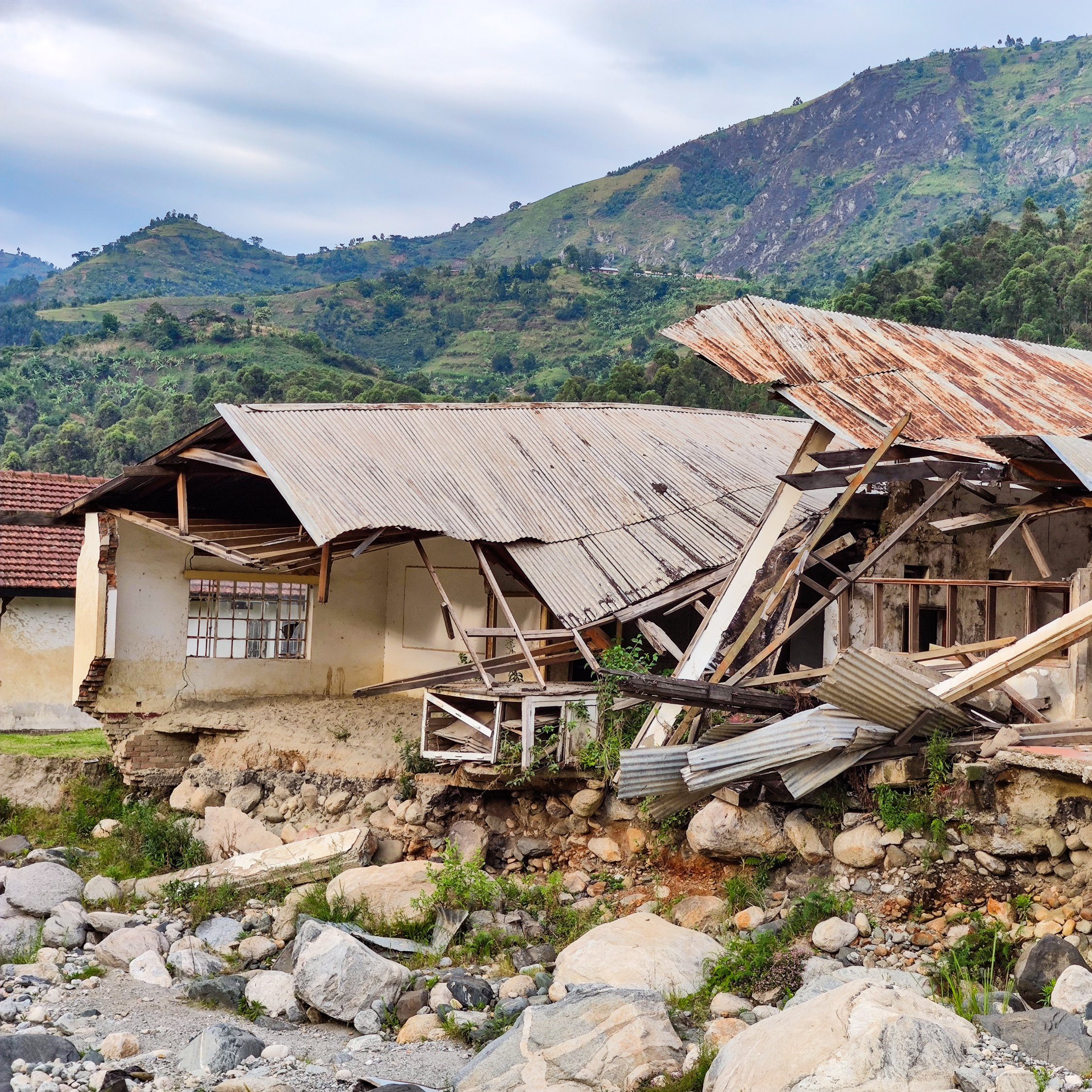

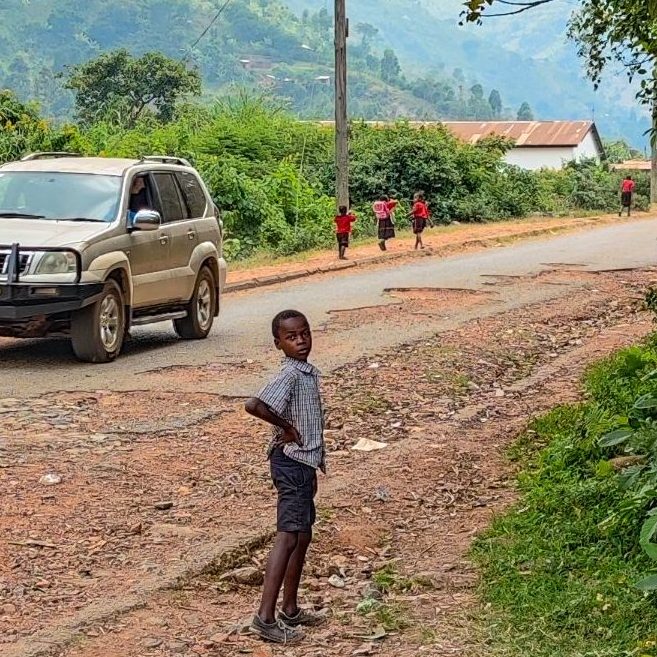
Time to read: 15min.
I had just returned from a long and exhausting high altitude expedition, climbing three 5000m peaks in Uganda and DR Congo. Well, returned is the wrong word. I had basically just gotten back to the pick up point after a full day of hiking from the upper camp. It was late afternoon already when I arrived at the starting location from where I began the climb many days earlier, an unnamed road in central Africa. The heat was intense, I hadn’t taken a shower in 10 days, wearing the same clothes, I was wearing when I initially came here, ready to go mountain climbing.
Mosquitos were swirling in the dry air, creating a high pitched, perpetual humming background noise. The busy main road was crowded with people trying to sell fruits and coffee beans.
The area had some other peculiarities which drew my attention. There was a massive hydro plant construction side. It appeared though, that no further investments were made and the construction stopped at the time of visiting.
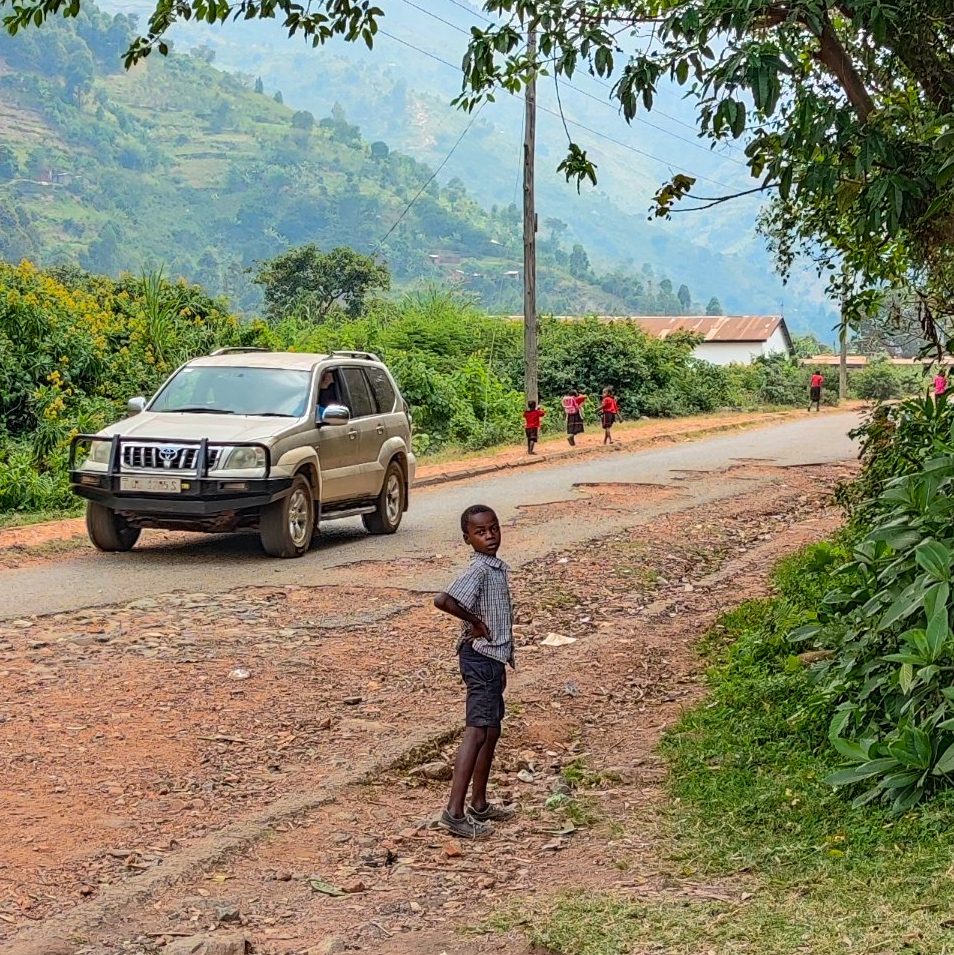

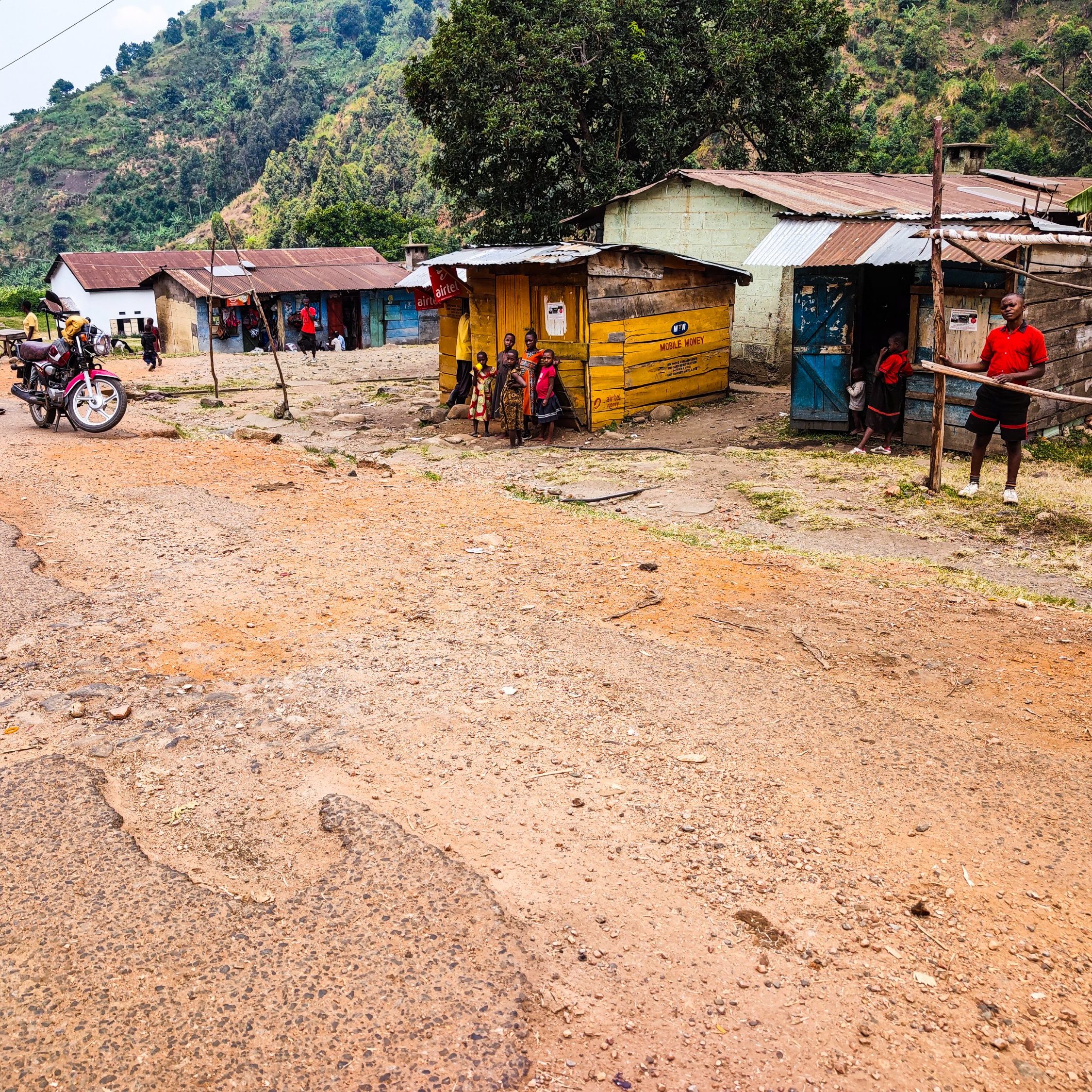
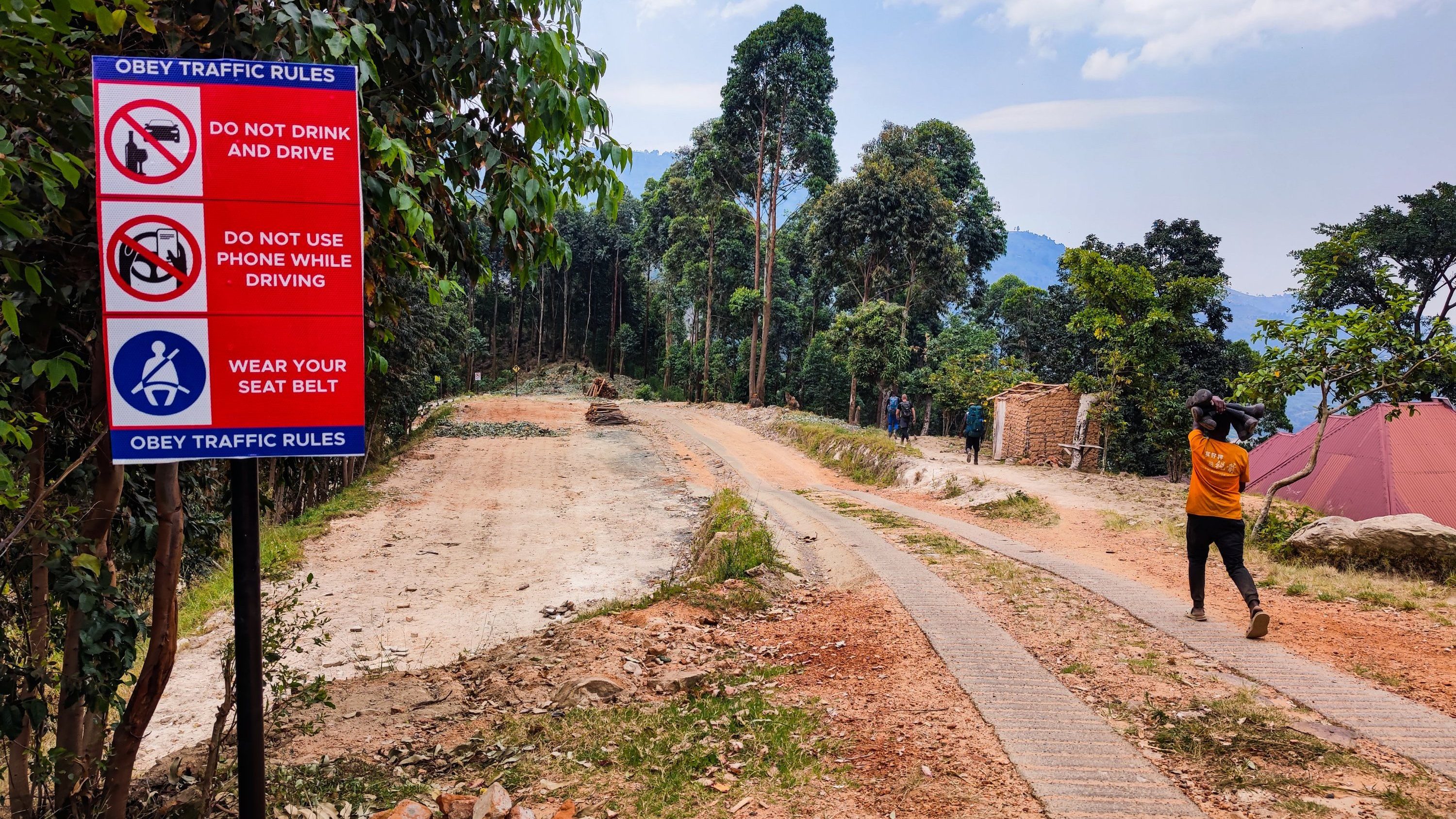
In addition, the region has been struck by immense floods in 2020, the same year a big wildfire has happened in the nearby national park which has destroyed big parts of the forest. Remnants of both events were still present, reminders of the impacts they had on both nature and people. The forest I hiked through on my way back was completely destroyed. Dry and foggy, the otherwise lush green trees have been turned by the fire into burnt, broken wood without any leaves or life. The fire in 2020 was probably man made, sparked by a cigarette, recklessly thrown on the ground, yet it wasn’t man who stopped it. A big storm formation brought rain, which fought the flames. Two years later, nature slowly began to reclaim the place and while most parts of the area lay still there, completely burnt, in between the broken trees, new life is already becoming visible for the eye willing to watch for details. Small bushes here and there, orange and yellow blossoms between the dry grasses. It will take many years, but I’m confident, it will grow back to its former beauty and floral diversity.


Unlike the main village. The floods have destroyed schools, buildings and infrastructure. While people have tried their best to rebuild some houses, or set up shacks to live in, the economical situation in combination with the little financial support they receive, made the area appear like the flood just happened a few weeks ago. Broken buildings framed the unnamed main road, the river bed had expended by the immense force of the water coming from the hills behind, bridges and parts of the road remained broken. Nothing has been rebuild yet.

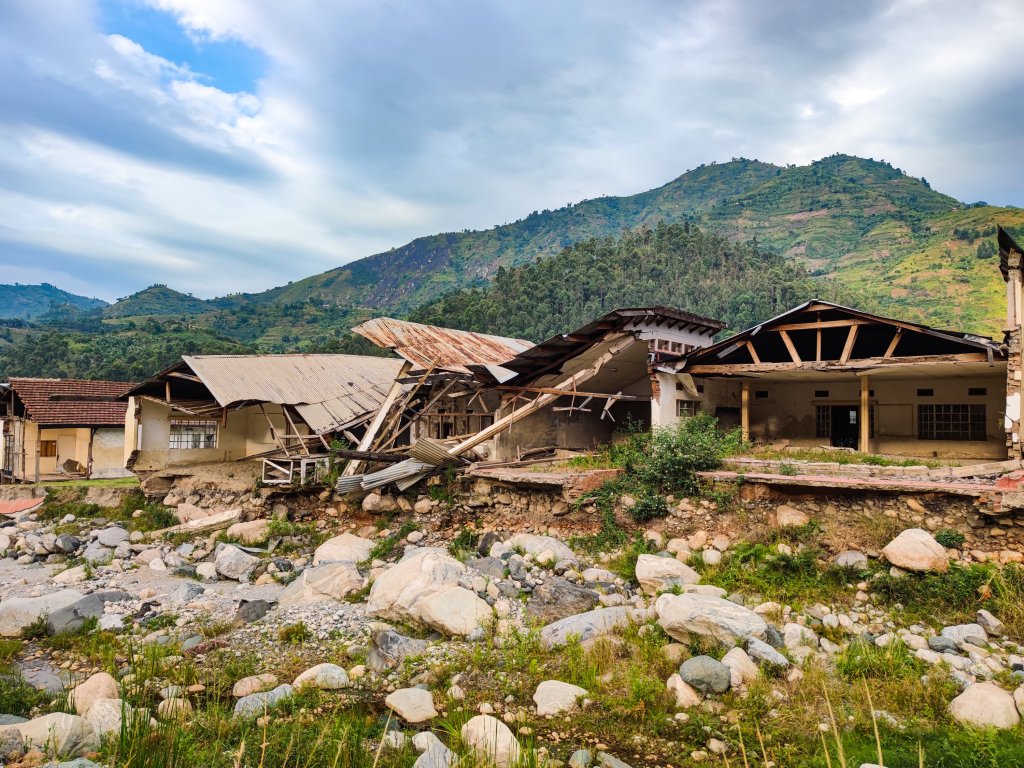
When driving there 10 days ago, I also noticed a huge mine on the left side of the river. It appeared to be abandoned because I couldn’t see a single person at the entire area, yet it looked like some goods had just been produced. I wanted to go inside, the moment I saw it for the first time.
Africa is rich in natural resources, yet the mining industry continues to exploit people and nature. In addition, mining happens partially in protected areas. A recent study from globalwitness.org found among other issues, the following:
– Miners are working in dangerous, largely unregulated conditions – with children exposed to toxic chemicals on a daily basis
Source: Global Witness, June 2017.
– Almost half the world’s remaining mountain gorillas are at risk as mining threatens Bwindi and Rwenzori national parks, part of the famous Virunga ecosystem, and also risks the economically critical tourism industry which depends on the country’s natural beauty and wildlife
– The country is deprived of tax revenues that could be spent on schools and roads
– Minerals from the Democratic Republic of Congo and South Sudan – that might be funding conflict and human rights abuses – pass through Uganda on their way to international markets

As you can clearly see on the map above, almost the entire country is one large mine, stretching into all protected areas, from north to south, east to west.
When my driver, Robert, picked me up at the said unnamed road, I asked him about a possibility to get into the mine. He was surprised I wanted to go, because I literally just had returned from climbing three 5000m peaks. But he also sensed my curiosity and told me he has a friend who could take me on a mine tour. Robert walked off, his phone in his hand. In the meantime, I talked to the porters with whom I’ve just spent 10 days in the national park. They were such nice people, we agreed to meet later this evening in the local club to celebrate a successful climb. Our little talk was interrupted by Robert, who told me that he knew someone who used to work in the mine and could show me around. But I would have to go immediately. I agreed. He wondered where I got all this energy from but then smiled. The mine was located about 10min by car from where we were, right on the way back. I made sure my big duffle back was in the car, as well as my backpack and we started the drive. I forgot my clean clothes at the pick up point. But that’s a different story.
We started driving. I was sitting on the backseat, getting my headlamp out of my backpack, I figured I’d need it in the mine. Yet a lively conversation unfolded in the car with Robert asking me questions about far away Europe and I forgot about the headlamp. 10min later, he stopped next to the road. A man dressed in blue pants was waiting there already. His shirt was clean, it had the logo of a brand I can’t remember on it. Robert stopped and opened the door. The man introduced himself. I don’t want to reveal his name, in this story, I will refer to him as Michael.
Michael was super nice. He agreed with Robert to be back at that very location in about 1h. In the meantime, Robert would drive all my bags to the hotel and then return in order to pick me up. He looked at me again and asked one more time whether I’m sure I want to go to the mines, on my own. I told him that I didn’t change my mind. He left.

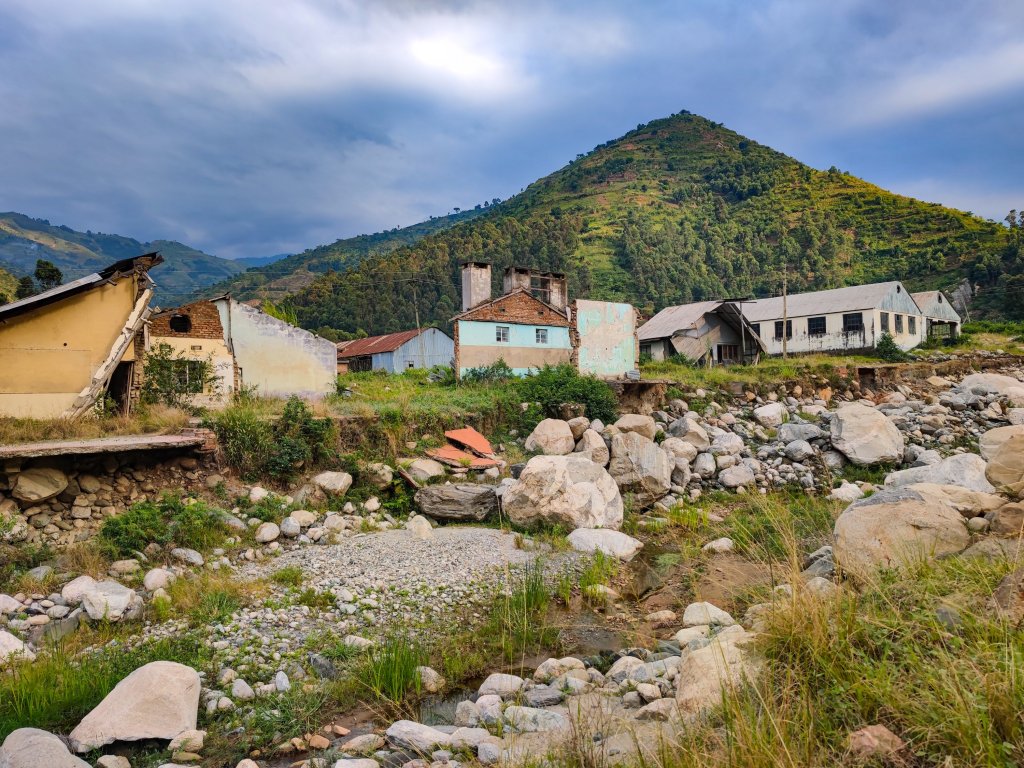
Michael tried his best to explain everything to me in English, yet he was lacking some vocabulary, which wasn’t a big deal. We understood each other pretty well, even without those extra words.
First thing we had to do on the way to the mine was to get to the other side of the river. I thought it wouldn’t be a a big obstacle, the river bed looked large, yet dried out. We crossed the road and climbed through some rocky sections and grasses to get to the shore of the river. Michael was very careful with choosing the path, instead of walking in a rather exposed area, he picked a way which followed some big rocks. I didn’t quite understand, it was for sure the tougher way.
No time to think further about it. We had to get to the other side of the stream, which was in fact much larger than it appeared from the distant road. There were some rocks in the middle, breaking the current of the water. Too far though to jump there from the shore. We had to take off our shoes and walk through the river. The water was cold, had sandy and rocky sections, it was up to my hips at some point. I was wearing shorts, it didn’t bother me they got wet. After a few minutes we reached the other side of the stream. The ground was sandy, I tried to clean my feet as much as possible with my dirty socks. The first kind of shower I took in more than 10 days, I thought. Back in my shoes, we continued.
Again, Michael carefully picked the detour through the rocky section. Walking through the river bed, I realized even more how immense that flood of 2020 must have been. The big rocks weren’t there before, Michael told me. They were flushed down from upper areas. We reached the ruins of a huge bridge, the first part of it was gone, the second part was still connected to the land, yet it was broken and its tip was partially submerged in the river. Another part of the stream we had to cross, following a big rocky section which split the river into two parts. But this time, those rocks made it easier, no need to take off our shoes, we could just jump from one boulder to the other.
On the other side of the riverbed, we had to climb up a steep, sandy slope. It was slippery, I had to use my hands to crawl up. Everytime I took a step, I slid backwards a little bit. It was a big effort getting up there, especially after already doing 25km of hiking that day. Once we reached the plateau, Michael pointed at another slope, again it led straight and steeply uphill, yet this tim through a little forest section and I had roots to hold on to.
Once we climbed the last, almost vertical section of the slope, we found a road. We walked on it for a bit further uphill. I couldn’t see the mine anymore and was wondering where we were at, but I trusted Michael and continued following him further into the forest. He was such a lovely person. Even though his English was far from perfect, we had plenty to talk and laugh about. A few people came along, ladies carrying some branches in wooden baskets on their heads. They asked Michael something in their local dialected and friendly greeted me. I answered with a smile. After another 10min on the road, we arrived at a green shack with a motorbike parked in front. It looked an outpost of security service personnel, yet no one was there.
When I looked to the left, I realized we had arrived, the mine was right in front of us, a huge building with rusty walls, most structures broken, some still intact.
On the left side, the office building, on the right the factory plants, a large corridor separating them.
I followed Michael to the entrance.
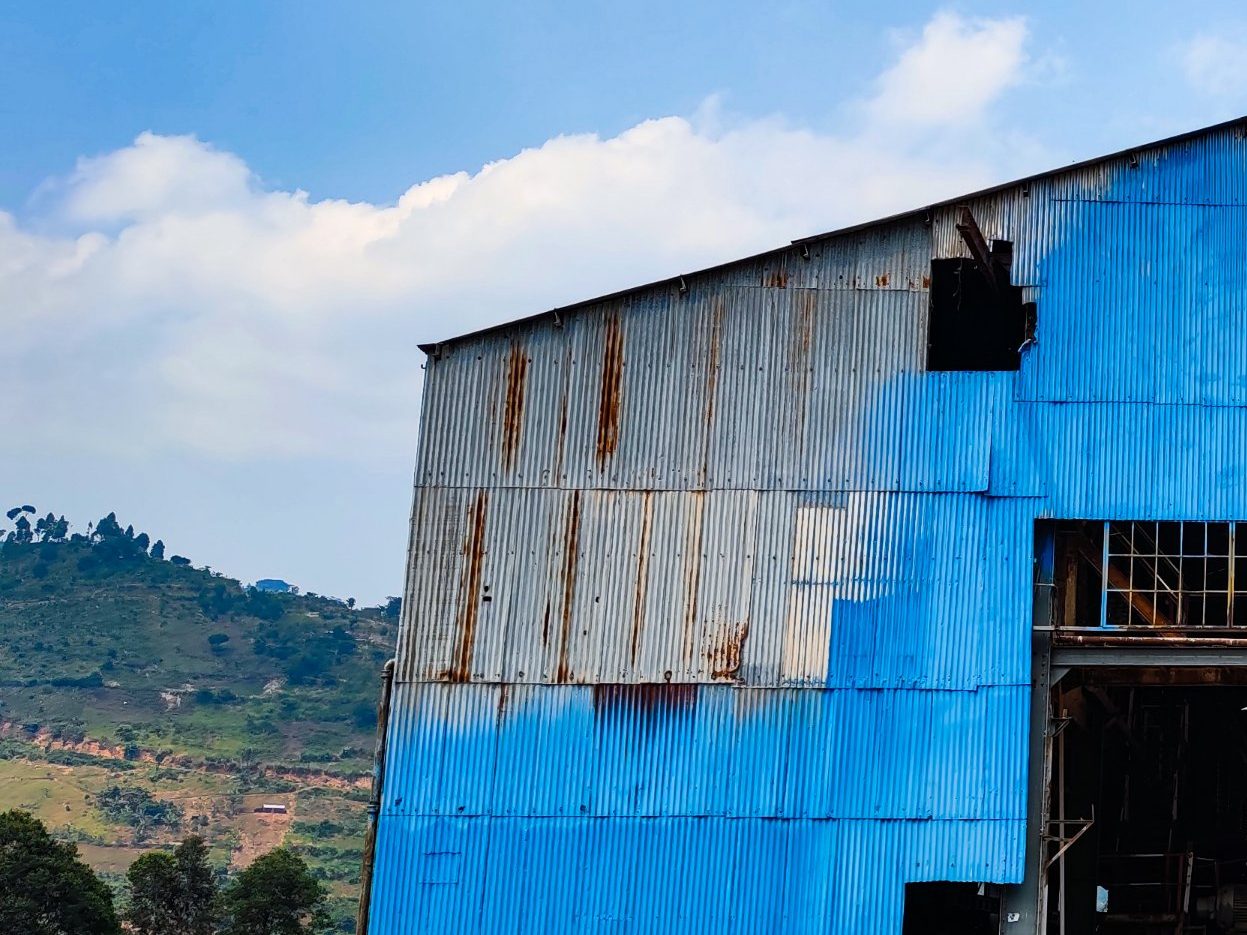

Every single door of the office was closed by a thick, rusty chain and lock, yet some of the glass windows were brocken, making it easy for curious visitors to enter.
We didn’t go inside the office, rather took a left and entered the first factory plant. A man in blue-checked shirt and brown pants, yet without shoes, was taking a nap, leaning back at one of the rusty steel girders. When we noticed us, he got up and walked away without saying a word. Michael didn’t seem to be bothered by his presence and told me to follow him up the stairs right next to us.
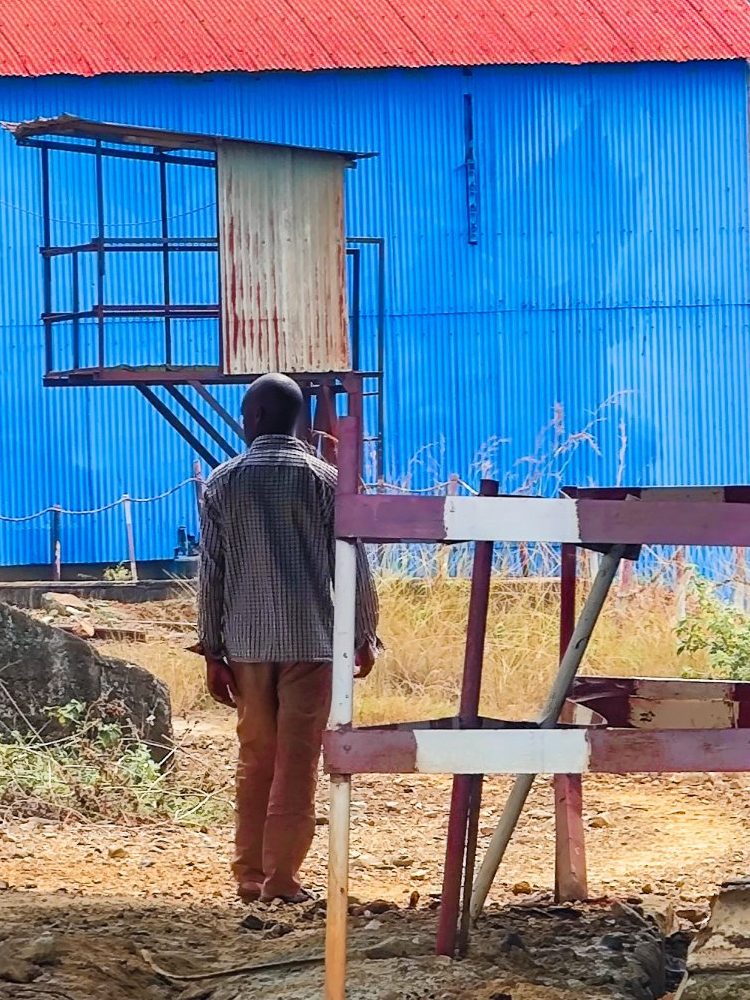
With every step we took, the steel grids underneath and above us were shaking. The plant wasn’t well maintained. After a few minutes we stopped right in front of a conveyor belt. Behind it, a large area stuffed with all kind of huge machinery. Spider webs were covering most of the structures made of iron an steel, the entire plant had some eerie charm. It appeared, someone had stopped the machines in the middle of production, for lots of raw material, rocks and minerals were still on them. Michael took his time to explain the purposes of every single machine, also the control system, which was a big grey box witch Chinese and Englisch instructions on it, also a sticker which said: “No alcohol when operating the machinery”.

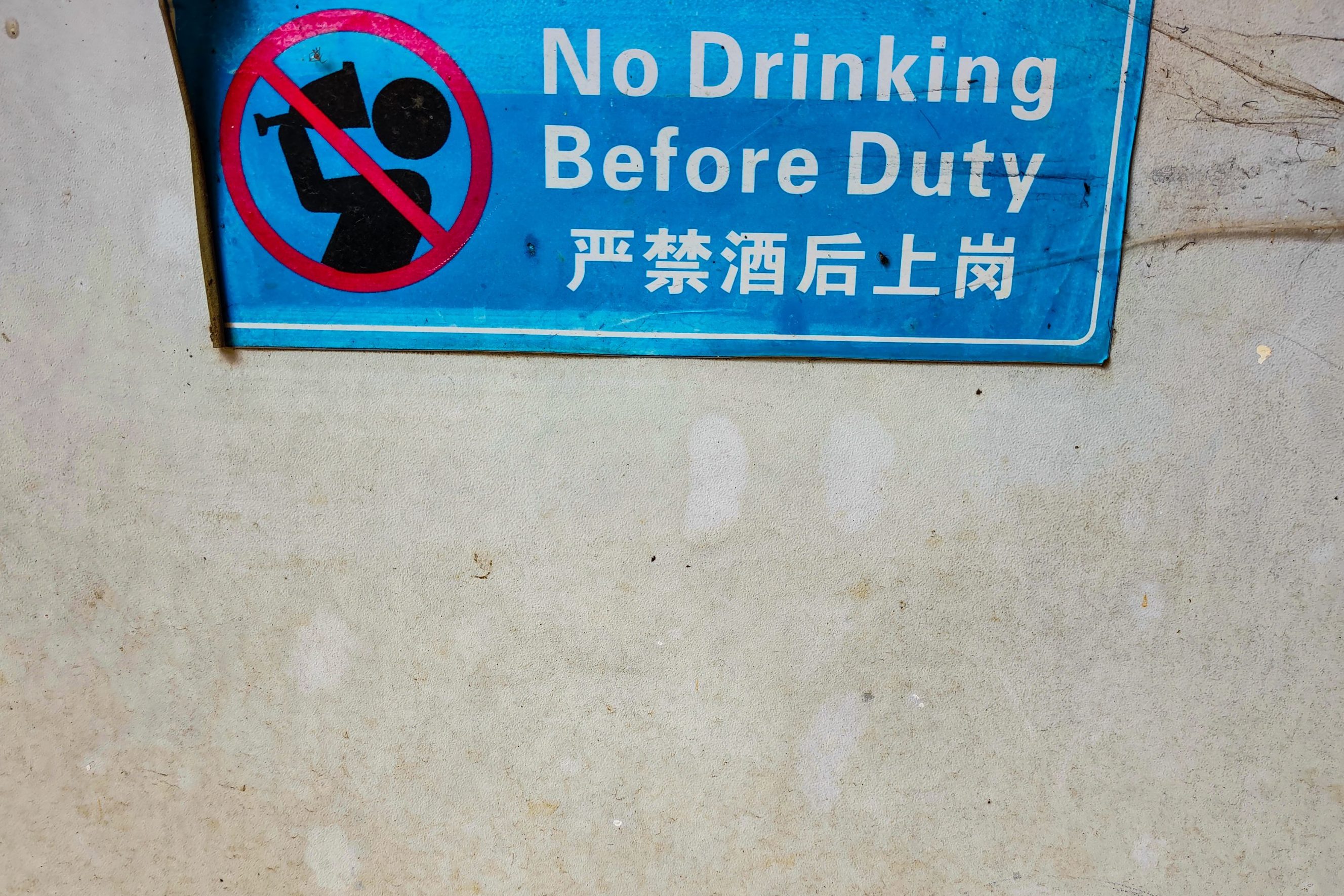
In fact, those mines haven’t been operating for almost four decades. There’s significant copper deposits in the area. Copper will most likely see an even bigger increase in demand within the next decades. It is part of almost every electronic device. Also solar installations require an immense amount of copper. It’s the combination of costs and the chemical properties which make the mineral so appealing for the industry.
That rise in demand will most likely lead to an increase in mining activities in many parts of the world, which could affect people and nature This is something which shouldn’t be ignored either and need to be considered in order to make this world a better place for everyone, also people living in areas which don’t get that much attention, like South America or Africa.
We walked though the huge factory hall all the way to its exit on the other side. Then Michael pointed at the entrance of the actual mine, a few hundred meters in front of us. Two small tunnel in the rocks, stretching many miles far into the mountains. In front of each were trails and a few broken freighwagons and steel pipes.
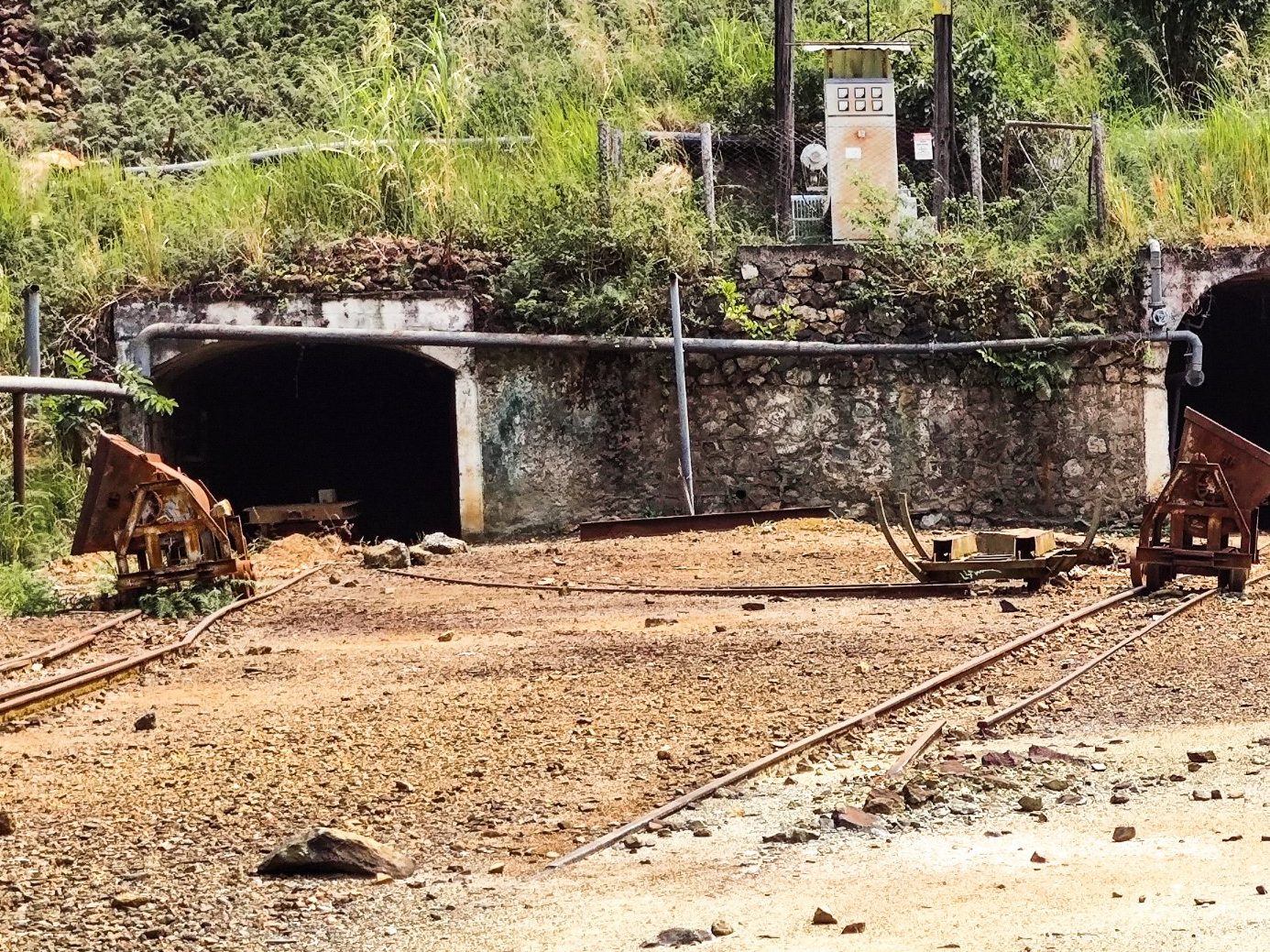
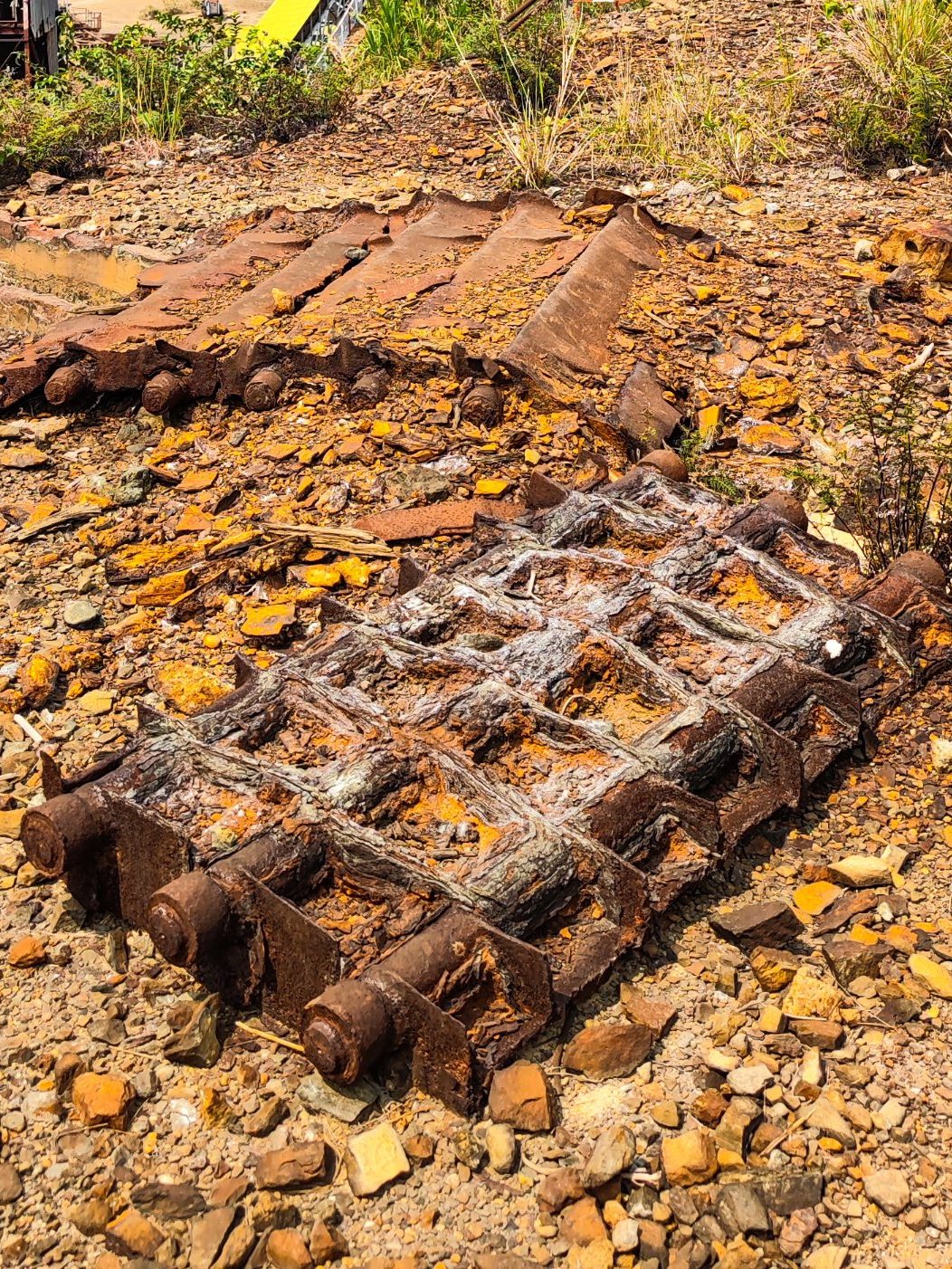
On the left side of the tunnel was another wooden shack, two men sitting in the shade of its roof, were starring at us with a fierce expression in their faces. I recognized one of them, it was same person taking a nap at the factory. Michael approach them and introduced me. I smiled at them and shaked their hands, immediately their expression changed and they both greeted me in a friendly way. They were curious and wanted to know, where I’m from, who I am. Michael answered in Swahili. Then he asked them for a torch. The man from earlier indicated to follow him inside the shack. There was no electricity, I held the door open for the daylight to enter the room so he could find what he was looking for. The man bended over and pulled out an orange box, he opened it and found the desired torch inside. A quick check whether it was still working properly and a few moments later Michael and I were on our way.
We followed the tracks into the unknown. I turned around every now and then, the daylight shining into the long corridor from outside vanished with every step we took forward a little bit more. Soon it was gone. The light of the torch was piercing through the darkness, lighting up our way. Michael showed me different structures and minerals on the walls of the tunnel, which had blue and yellow colors. It looked like we were walking trough a maze of crystals. I wondered how the place would look like if it was properly lit. Every area touched by the light of the torch was sparkling like someone had covered the walls with thousands of little diamonds.
We passed by several other tunnes to our right and left which led to different areas of the mine. It would have been easy to get lost there.
Michael said, he used to work at the mine, that’s why he knows the area so well. It was later bought by a Chinese company many years ago but didn’t bring the desired return on investment, therefore the investors left and abandoned the mine. The government kept looking for a new owner since then, but didn’t find anyone yet. Therefore they contracted some people to maintain the mine.
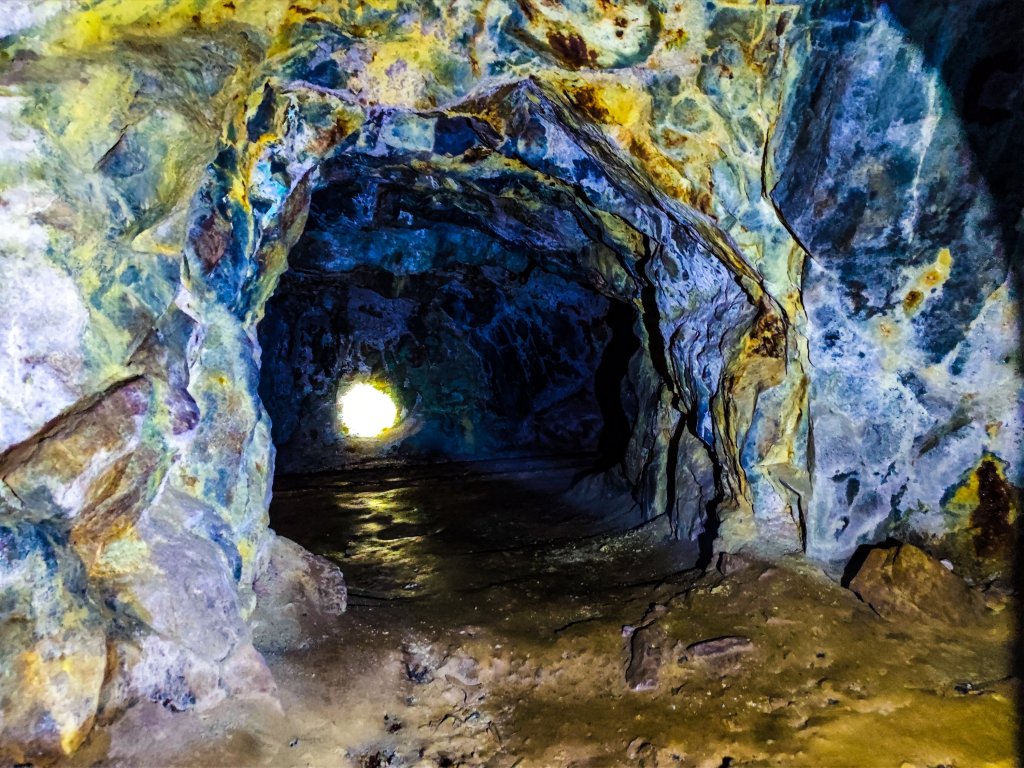
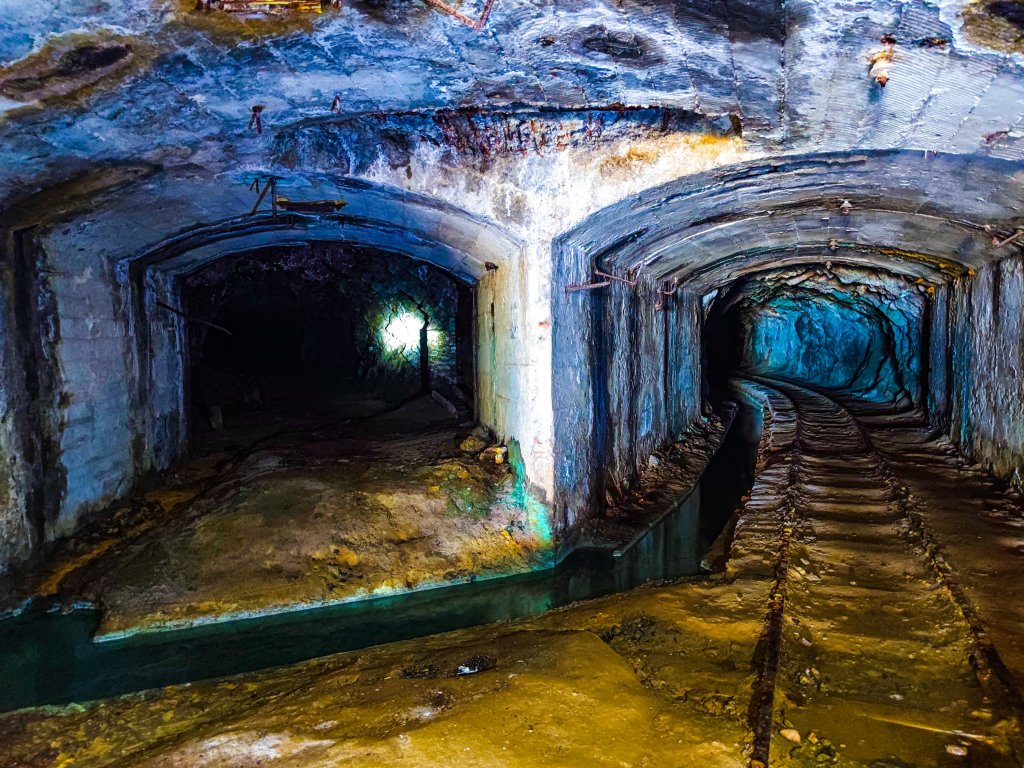
It was cold, compared to the dry heat outside, I felt like I should have brought my jacket. While we continued walking, I heard something which sounded like a river. Michael stopped at another subterranean junction, we took a left and reached another tunnel. My guess was right. A little stream of water, its source far inside the mountain, was searching its way outside the mine. It was of a turquoise, blueish color. But it actually wasn’t the waters color, rather the color of the ground. Minerals which settled on the bottom of the stream gave it that particular color. It was a slime like substance, with a particular smell I can’t describe.
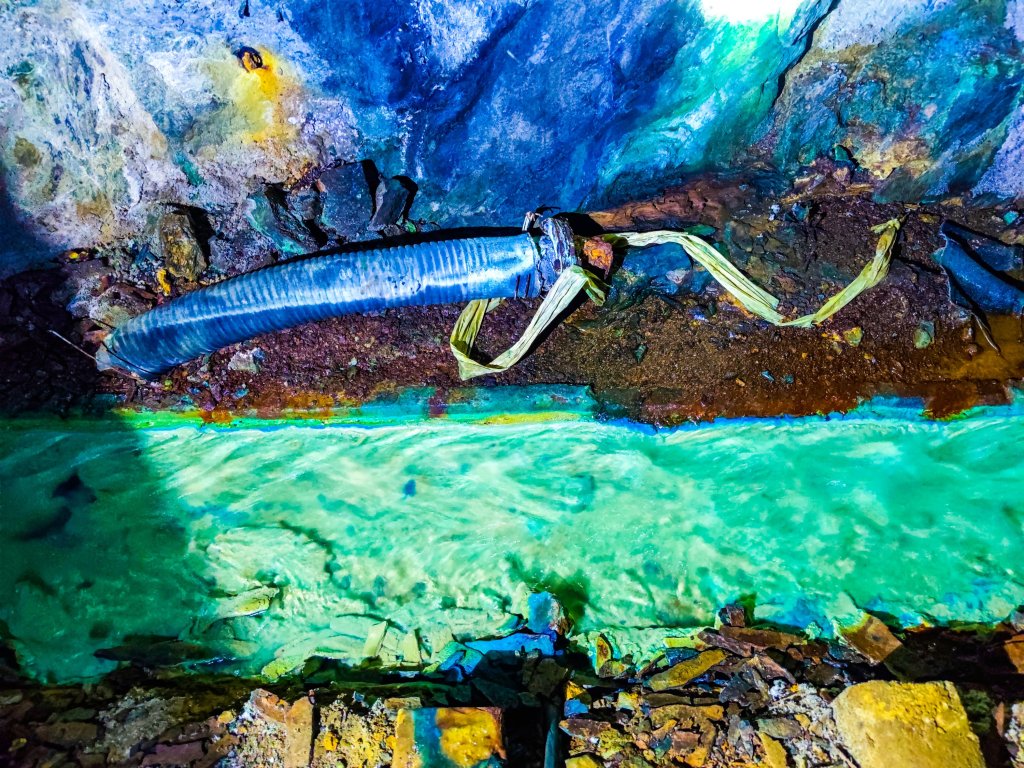
I never doubted Michaels sense of orientation, we reached a point, so far inside the mine, even with the strongest torch, I wouldn’t have been able to find the way back to the exit.
If Michael were to leave now, I probably would have followed the stream. That has worked in the past already, when I got lost in the jungle of a tropical island in the South Pacific. I couldn’t find the way out, yet following a stream, I got back to the ocean and eventually found the main road again. But the situation in Africa was way different. A tropical island can’t be compared with an abandoned copper mine.
Many thoughts went though my head. Who had constructed this place? What if an earthquake was to hit while being inside? What if the water level would rise?
Michael told me we should turn around, and in fact, follow the stream back out.
It was weird. I felt uncomfortable yet so full of adrenaline, I wanted to leave yet continue at the same time. But agreed to Michaels suggestion to leave. We shouldn’t push it too far.
After 15min, it got brighter and I saw the daylight again. There was something moving at the entrance, it was rather small, but quick. My eyes had to get used to the bright light first, and only when getting closer, I realized it was a goat eating some grass next to the blue colored stream. Little thing, I hope it won’t get poisoned but it probably didn’t feed there for the first time.
I felt at ease to be back outside, even thought the heat appeared to be a little bit hotter, the sun shined a little bit brighter. Michael suggested to take a different route back, so he could show me some other parts. I agreed.
We walked for some time on a dusty path, leading to a big pile of minerals, it looked like the ruins of a skyscraper, stretching far above our heads. Michael, working in the mine for years, had a trained eye. While I couldn’t see anything but a pile of rocks, he immediately found gems among the stones. Under a thick layer of dust, which Michael rubbed into is shirt, beautiful, unexpected shades of blue and green became visible. He gave them to me as a present.

It wasn’t until that moment when I realized how late it already was. Robert must have been waiting at the other side of the riverbed for an hour at least. We hurried back, through the other side of the factory, passing the conveyor belts, the office building far in the distance. We climbed through the forest section back to the road and soon we found us right in front of the steep slope again, which we slid down sitting, back to the river. Michael led the way through the rocks, through the two streams and the grass, back to the main road, where Robert was already waiting for us. He was worried and already tried calling Michael, yet there was no service at the mine area.
I thanked Michael, but felt at easy to be back at the car.
I wished him all the best and continued the drive back to the hotel with Robert, ready to take a shower and get into some clean clothes. Only to find out, I forgot them at the pick up point, about 1h drive away. Well, yet another day in dirty clothes, but, I was able to see an African mine, and without hesitation, I’d do it again.
The copper mine right at the entrance of two big national parks covers a large area already. Asking the locals about the possibility of an expansion into the protected regions, they all agreed, that if business would be continued, further parts of the national parks would become mining areas.
All workers in mines need our utmost attention. They require fair and safe working conditions. Along with strong laws to protect the landscapes.
Exploring areas like that, gives you experiences which can’t be found elsewhere. I feel honored to be able to write about my impressions and share them with you.
If you liked the story, please share it with your friends and family and subscribe to my blog to receive updates.
Leave a comment